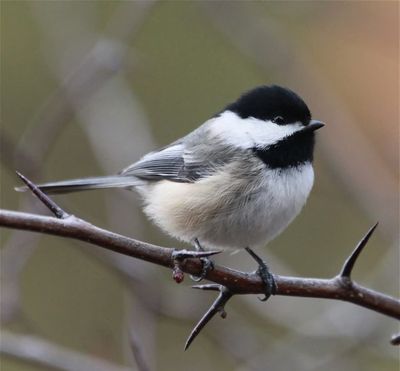Cool Critters: Chickadees – charming, chatty and seriously cerebral

Chances are, the melodious namesake call of the black-capped chickadee has brightened your mood while walking, shoveling snow or pulling weeds: chickadee-dee-dee.
Here in the Inland Northwest, this tiny, feathered ball of energy is always in season. With its black cap and throat against white cheeks, the bird is easy to spot and easy to hear.
Common visitors to our backyard feeders, black-capped chickadees are chatterboxes that flit about in small groups called a banditry. Winter or summer, Carol Schulz Ellis observes them daily around her home in Mead.
“I especially love their friendliness, their inquisitiveness and their chatter,” she said.
Four of North America’s seven chickadee species live here in Washington state, according to the Washington State Department of Fish and Wildlife, and the black-capped variety is the most common.
If birds attended high school, the black-capped chickadee would be a standout student. Besides being cute, curious and chatty, they are remarkably brainy.
“Memory geniuses,” is how researcher Dmitriy Aronov of Columbia University’s Zuckerman Institute describes them.
Scientists have long known that black-capped chickadees stash seeds, insects and other food morsels in hundreds, if not thousands, of locations spread over several acres – only to return and retrieve them weeks later in winter.
Even so, a big question remained: How could such a tiny bird have such a big memory? (Fellow humans, do you remember where you stored every single Easter egg?)
In a March 2024 study published in the journal Cell, Aronov and colleagues concluded that the birds’ brains deploy a neural pattern similar to that of a bar code to recall the locations of each food cache, whether wedged into tree bark, a house shingle or cracks in the ground.
“The black-capped chickadee is a tiny bird with one of the most extraordinary capacities for memory in the animal world,” Aronov said in a Columbia University news release.
And there’s more. The black-capped chickadee’s uplifting call? It’s loaded with information. “Chick-a-dee-dee” conveys that, hey, all is good to its flock mates. But the message communicates urgency when they add “dees” to the end of each call, according to the Cornell Lab of Ornithology, and the more “dee” notes, the greater the threat.
“Chickadees make their chicka-dee-dee-dee call using increasing numbers of dee notes when they are alarmed,” it states on its website. Also, very high-pitched “dees” is a signal to others that a predator such as a hawk or owl is close by.
“When chickadees hear this call, they freeze in position until they hear a chicka-dee-dee call signifying ‘all clear,’ ” the Cornell site says.
Scientists have also found that the chickadee’s alarm call is so effective that it alerts other bird species as well. Birds such as nuthatches, jays and warblers will respond by hiding, or if their flock is big enough, by mobbing an approaching predator to chase it off.
Beyond having remarkable memories and communication techniques, chickadees are all-round nice guys – the kind you’d invite to a dinner party or a political rally, perhaps.
“They never get into scuffles or fights and don’t monopolize the feeders,” said Ellis, of Mead. “All in all, they set a good example for us humans.”